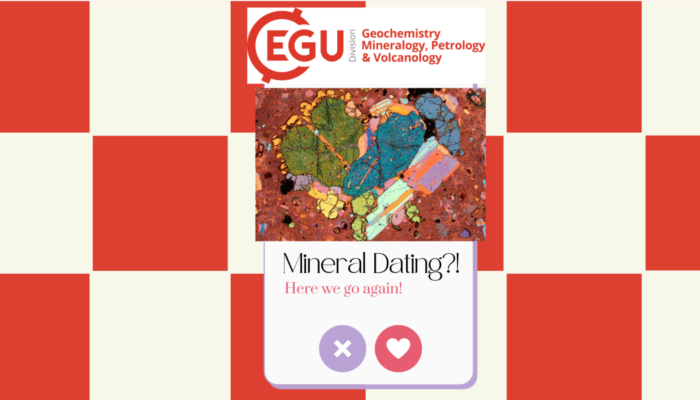
Whether the first four robust candidates for the love of your (geological) life did not match your expectations (if you missed part one, check it here) or you are feeling polyamorous looking for some other options and perspectives, other bachelors/bachelorettes datable phases can be everything you have been looking for.
Here are some other minerals used in geochronology, as if they were featured on online dating apps, plus some ‘reviews and red flags’ from previous lovers users. Caution (and definitely further research!) is advised.

Rutile and Titanite dating profiles (Grains as in Pape et al. 2022 and Miler et al. 2019)
RUTILE (TiO2)
Stable, resistant, versatile. Bring the heat up and let’s get the (P-T-t) recording going.
ID-TIMS, LA-ICP-MS, and SHRIMP oriented, depending on how posh you are feeling.
High-grade conditions, trace elements distribution, and thermal histories are my mojo. I have been everywhere and I’ll tell you what happened, when and in which conditions.
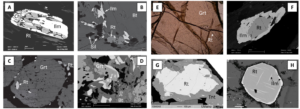
Rutile formation in prograde (A-C) and retrograde (D-E) settings and its replacement for titanite (F) and ilmenite (G) (as in Zack and Kooijman, 2017).
Reviews and red flags:
- ‘Though a great teller, he doesn’t seem to fit in all environments’, a.k.a. rutile is not as ubiquitous as zircon or apatite, and may not be present in all rock types, limiting its applicability in some geological contexts.
- ‘He can get overwhelmed’. Partial resetting of the U-Pb system can occur due to its fast diffusion, complicating age interpretations if the rock has undergone multiple metamorphic events.
- ‘He doesn’t really concentrate on U’. Rutile retains lower concentration of uranium than other mineral phases, so obtaining precise U-Pb ages can be tricky, especially in younger rocks.
- ‘A lot to tell, it can get messy if you aren’t up for the task’. Multiple generations can be formed during metamorphism. Distinguishing between them can be challenging and requires detailed microstructural and chemical analysis to avoid misinterpretations of ages.
- ‘He can sometimes be too influenced by friends’. Inclusions of other mineral phases, such as zircon, can lead to mixed age signals and inaccurate dating. Be aware.
TITANITE (CaTiSiO5)
Diverse, sensitive and flexible, what else could you ask for?!
ID-TIMS, LA-(MC)-ICP-MS, and/or SIMS, you name it, I’m there.
Best known for: constraining igneous and metamorphic events, tracking sources and differentiate between crustal and mantle processes, dating peak to retrograde metamorphism and cooling histories in medium- to high-grade metamorphic terranes, giving insights into pressure and temperature (P-T) conditions from trace elements incorporation and into multi-stage geological histories from recrystallisation. This babe can do it all honey!
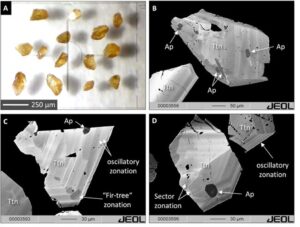
Titanite in (A) stereomicroscopic image; and (B–D) BSE images featuring compositional zoning and inclusions of apatite (as in Kawohl et al. 2022)
Reviews and red flags:
- ‘Too complex, couldn’t deal’. Complex zoning due to multiple generations of growth and/or metamorphic overgrowths will require high-resolution methods to accurately identify and date each growth zone.
- ‘Could not keep things low-key…, er… T’. Prone to alteration and recrystallisation, especially in low-temperature, high-fluid environments, titanite can suffer Pb loss or resetting of the U-Pb system, complicating its age interpretations.
- ‘Moody and weak at times’. Titanite’s uranium and thorium contents are variable, and in cases of low U or Th, age determination via U-Pb can be challenging due to weak radiogenic signals. Detailed characterisation before dating to ensure reliable results is recommended.
- ‘Changes depending on the gang and vibes. Trust issues?!’. Closure temperatures are different for distinct isotopic systems, which can lead to discrepancies in multi-isotopic studies and complicate thermal history interpretations. Moreover, inclusion of other mineral phases may contribute with radiogenic Pb and skew the isotopic ratios (always be careful with sample preparation and during analysis to avoid erroneous results, okay?!). All in all, make sure to know what you’re facing babes.

Xenotime and Epidote dating profiles (Grains as in Szamalek et al. 2013 and Achab et al. 2017)
XENOTIME (YPO4)
Multi-approachable, heated just enough, sensible, (re)fine(d). I didn’t come to play!
ID-TIMS, LA-ICP-MS, SHRIMP, and/or SIMS, where are we meeting?!
Lead-free and robust age determinations and interpretations in both U-Pb and Th-Pb systems; ability to record medium- to high-grade metamorphic events (closure temperature of ~600-700°C for U-Pb); peak metamorphism and protracted cooling histories oriented; sensitive to trace and rare elements incorporation offering insights into different growth environments; often preserved in sedimentary rocks and can be used to date diagenetic processes; and last but not least, useful for dating of small volumes, especially useful in metamorphosed or altered samples, as crystals can be fine-grained and even sub-micrometer in size. A complete package at your pleasure.
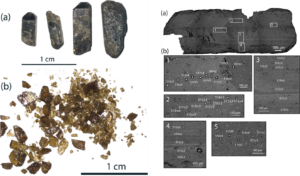
Xenotime crystals from Datas (Brazil) as potential reference material for U-Pb geochronology (as in Vasconcelos et al. 2018).
Reviews and red flags:
- ‘A complex being’. Xenotime commonly exhibits complex zoning, especially in metamorphic contexts where it may grow in multiple stages. Watch out for mixed ages and misinterpretations.
- ‘Really demanding’. High-resolution techniques are often needed to obtain reliable ages in cases of low concentration of U and Th, especially in younger rocks. The same is valid for potentially fine-grained crystals and those with complex internal structures.
- ‘Way too sensitive and easy to influence’. Xenotime can undergo recrystallisation or overgrowths in the presence of fluids, which can disturb the U-Pb system and lead to partial or complete resetting of ages, challenging possible interpretations.
- ‘Well, it was complicated, to say the least…’. REE content, although valuable for petrogenetic studies, can vary significantly within individual grains, requiring careful calibration when interpreting trace element data. This variability can complicate comparisons across samples or regions.
EPIDOTE [(Ca2)(Al2Fe)(Si2O7)(SiO4)O(OH)]
Stable, complex, resistant, sensitive and plural. I could be the one! Shall we find out?!
LA-ICP-MS and SIMS are my best mates, but we can give it a try in other posh settings.
I’m your guru for fluid pathways, metamorphism and thermal evolution, especially in subduction zones and hydrothermal settings: record of different geological events and fluid histories, either prograde or retrograde; resistant to low-temperature alteration; abundance in subduction-related contexts; highly responsive to fluid-rich environments; and incorporation of both U-Pb and Sm-Nd systems. Drinks on you and I spill all the gossip!
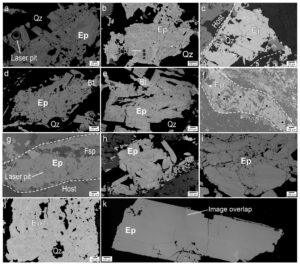
BSE epidote grains (as in Peverelli et al. 2024).
Reviews and red flags:
- ‘I just needed more out of this relationship’. U and Th content can be quite low in cases, which poses challenges for obtaining precise U-Pb or Th-Pb dates.
- ‘Too many layers to deal with. I was overwhelmed’. Epidote often shows compositional zoning, particularly in response to fluid interaction, temperature, and pressure changes. These zonations can lead to mixed age signals and necessitate high-resolution techniques to accurate age determinations. Moreover, while fluid sensitivity is a major advantage, it also complicates geochronological interpretations. Multiple stages of fluid interaction are likely to result in more complex isotopic signatures. Careful analysis and ideally multiple isotopic systems should be used to unravel the age and nature of each event.
- ‘When things heated up, all was changed’. Recrystallisation or overgrowth is possible in high-grade metamorphic conditions, leading to partial or complete resetting of isotopic systems. Caution is advised for such conditions.
- ‘Couldn’t really define crucial info’. The closure temperature of the U-Pb system in epidote is not well-defined and can vary based on chemical composition and geological context. This variability makes it challenging to directly compare epidote U-Pb ages with other minerals like zircon or titanite in the same rock, which have more defined closure temperatures.

Calcite dating profile (Grain image as in Gelencsér et al 2023).
CALCITE (CaCO3)
Available, resourceful, sensitive, ‘new’ to the game but ready. Swipe right and let’s get going.
LA-ICP-MS and ID-TIMS are my go-to pals.
Sedimentary, hydrothermal, tectonic, name the environment and I’m there. Always ready to date low-pressure geological processes – including diagenesis honey, to spill all the tea on sedimentary basin evolution, paleoclimate, fluid flow, faulting events, hydrothermalism, and tectonics. Bring the questions and we can get the date (or should I say age?!).
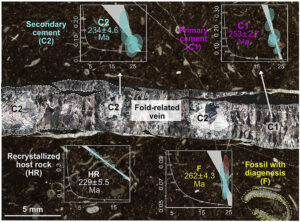
U-Pb calcite ages corroborate the fluid-rock interaction during deformation. Primary and secondary cement from a fold-related vein, as well as fossil, and rock-matrix ages were obtained (as featured in Palacios-García et al. 2023)
Reviews and red flags:
- ‘Too limited for me. Was expecting more’. Low U and Th content are typical and will limit the precision of your dating, especially for younger samples. Calcite’s potential for low U concentration and high susceptibility to lead contamination calls for meticulous sample preparation and calibration to ensure reliable ages. New studies are focusing on improving dating accuracy, but as of now watch out for detection limits and imprecise data.
- ‘An open book. And not always in a good way’. Reset or partial disturbance of the isotopic systems due to dissolution, recrystallisation, and alteration during diagenetic or metamorphic events is always a possibility in tectonic settings. Be careful.
- ‘Too many layers to unpack. Tiring!’. Calcite often grows in multiple stages and may recrystallise or precipitate during different events. Separation of these different stages requires time, caution and high-resolution techniques.
- ‘Lack of definition’. The closure temperature of U-Pb and U-Th systems can be variable and highly context-dependent. Comparisons with minerals that have more stable closure temperatures, like zircon, are thus more challenging, as calcite ages may reflect more complex thermal histories.
—
Final note: A more thorough study of the application of the aforementioned minerals in geochronology is strongly recommended, as here the information was shortened and adapted to fit the purpose of the article, mimicking what is commonly seen in online dating profiles. The ‘Petrochronology: Methods and Applications’ series, edited by Matthew J. Kohn, Martin Engi and Pierre Lanari, and the following references (and the references therein) were used here and constitute a good start point:
Peverelli, V., Ewing, T., Rubatto, D., Wille, M., Berger, A., Villa, I. M., Lanari, P., Pettke, T., Herwegh, M. (2021). U − Pb geochronology of epidote by laser ablation inductively coupled plasma mass spectrometry (LA-ICP-MS) as a tool for dating hydrothermal-vein formation, Geochronology, 3, 123–147.
Peverelli, V., Berger, A., Wille, M., Pettke, T., Putlitz, B., Mulch, A., Gnos, E., Herwegh, M. (2024). Multifaceted orogenic fluid dynamics unraveled by hydrothermal epidote, Eur. J. Mineral., 36, 879–898.
Simpson, A., Gilbert, S., Tamblyn, R., Hand, M., Spandler, C., Gillespie, J., Nixon, A., Glorie, S. (2021). In-situ Lu–Hf geochronology of garnet, apatite and xenotime by LA ICP MS/MS. Chemical Geology, 577: 1-16.
Simpson, A., Glorie, S., Hand, M., Spandler, C., Gilbert, S., and Cave, B. (2022). In situ Lu–Hf geochronology of calcite, Geochronology, 4, 353–372.
Wu, S., Yang, Y., Roberts, N.M.W. et al. (2022). In situ calcite U−Pb geochronology by high-sensitivity single-collector LA-SF-ICP-MS. Sci. China Earth Sci. 65, 1146–1160.
